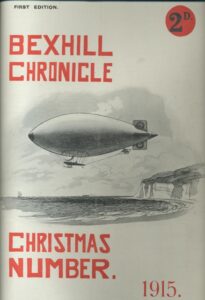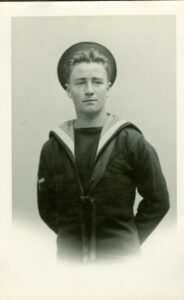Conflict in the Sea and Skies
When people think of the Great War, they often imagine muddy, rat infested trenches and battlefields scarred with bomb craters and corpses. However the war was also a maritime conflict and the armed forces were quick to exploit the newly invented aircraft.
Bexhill in the Air
The Army formed the Royal Flying Corps in 1912 and the Navy formed the Royal Naval Air Service in 1914. These services were very technical and carried out surveillance, aerial photography and wireless telegraphy. As well as becoming pilots, some soldiers were also occupied in the maintenance of aeroplanes and airships. In April 1918 both services merged into the Royal Air Force.

Bexhill was not bombed during the First World War, but on the night of 25th September 1916, a Zeppelin L31 was spotted on its way to attack Portsmouth. The Navy’s coastal patrol airships, based at Polegate, were another common site. During 1918 Bexhillians were also given the opportunity to get a close up view of an Avro 504 training aeroplane which was parked outside the Kursaal as part of a War Bond appeal.
Approximately 70 Bexhillians served in the air services; 24 in the Royal Flying Corps, 27 in the Royal Naval Air Service and 20 in the Royal Air Force. Among them were Herbert Vieler a well-known local photographer, Herbert Gray, the mayor’s son who ran away to join the Royal Air Force, and Richard Walker and Stuart Coppard who both flew on operations. Sadly Harold Whiteman, an Australian of Bexhill descent, was killed whilst learning to fly.
Bexhill at Sea
Britain’s navy was revered across the globe and was the largest in the world. Although Germany attempted to avoid naval battles and concentrate of submarine warfare, many sea battles did take place in the North Sea, the North Atlantic, the Mediterranean and the South Pacific.
The most powerful German fleet, outside the North Sea in 1914, was the “East Asiatic Squadron”, under the command of Vice Admiral Graf von Spee. The squadron had been patrolling the China Seas but headed south with the intention of returning home via Cape Horn, when it met a British Fleet coming the other way. A battle ensued, just off the west coast of Chile, near the city of Coronel, from which the battle takes its name. The German squadron, led by the armoured cruisers “Scharnhorst” and “Gneisenau”, was superior in strength to the British whose main force comprised of two rather older and less well-armed armoured cruisers, “Good Hope” and “Monmouth”. Both British ships were sunk, and the crew lost, an almost unheard of British defeat. On board the “Good Hope” were two local Sussex men – one sailor, whose surname was Rowe, and who had a brother serving in the Bexhill Coastguards, and William Miller, from the village of Hooe.
Submarines and the Merchant Navy
As an island nation, Britain also relied heavily on shipping and the Merchant Navy for supplies. In 1917 Germany decided to try and starve the British people into surrender by introducing unrestricted submarine warfare to attack merchant shipping to prevent supplies from reaching Britain. Germany sank 5,000 ships, 25% of the Allied merchant fleet. To combat this, the Allies brought in the convoy system, where Royal Navy ships would travel in convoy with merchant vessels to provide protection from submarines. Minesweepers would also often travel in front of convoys to clear mines from the path of the ships.

Many Bexhill men served in the Royal Navy and the Merchant Navy. James Matthews was 2nd Officer on board the cargo ship, S.S. Clan Ferguson and Herbert John McCreedy from Terminus Road, was an Able Seaman on the submarine, H.M.S B9. Able Seaman, Alfred John Adams from Lewes Lass Cottages, Sidley served on board the H.M.S. Osprey. Lieutenant Commander Gilbert George Sackville, 8th Earl de la Warr, served on the H.M.S. California and later commanded the motor cruiser Nord Est.
Dazzle Camouflage
English artist, Edward Alexander Wadsworth, was one of several artists who were asked to design some form of camouflage for ships that, hopefully, would reduce the shipping losses. He produced what became known as “Dazzle” camouflage, complex patterns of geometric shapes in contrasting colours, which didn’t hide the ship but made it very difficult for a submarine to determine its type, size, speed, and heading. Wadsworth also painted the mural on the wall of the De La Warr Pavilion restaurant.
Minelayers & Minesweepers
Serving on the minelayers and minesweepers was a hazardous job. Their task was to lay mine fields across shipping lanes, while also keeping certain areas clear for British ships to travel through safely. They were also responsible for clearing enemy mines which was highly dangerous. The Admiralty found that fishing boats, trawlers, all types of ferry boats and pleasure boats, including old paddle-steamers, were ideal for this type of work.
The crews were a mixture of Royal Navy officers, often retired senior officers called back into service, members of the original crew, and volunteers and conscientious objectors. Herbrand Sackville, the 9th Earl De La Warr volunteered for minesweeper service even though he was underage at the time of call-up.
Futher information about Aviation & Naval during WW1

